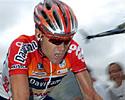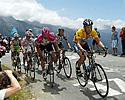
Recently on Cyclingnews.com |
|
|
View from the lab - Ric Stern's Tour de France sports science
British ABCC coach Ric Stern (www.cyclecoach.com) is a regular contributor to Cyclingnews' Form & Fitness section along with being a full time coach. Still an active rider when time allows, Ric will be providing a physiological insight into the challenges that face the riders in the Tour.
July 20, 2005: Maintaining an attack

|
Stage 16, the final day in the Pyrenees. With the two big climbs of the Col de Marie Blanque and the Col d'Aubisque, followed by a long descent and generally a gradual downhill into Pau, there was plenty of hard work for the riders. Having ridden this stage myself (albeit in the opposite direction) I knew it would be a tough stage; however, I wasn't expecting as many fireworks as the stage produced!
Firstly, we saw an excellent break go up the road, where Oscar Pereiro ended up with a stage win he deserved and Cadel Evans took time back on the GC contenders to move up from 11th to 7th on the GC.
However, it was back in the maillot jaune group where there were some surprises - or at least I wasn't necessarily expecting them. We saw repeated attacks from the man who has probably attacked more times than anyone else in the Tour this year - Alexandre Vinokourov, plus there were attacks from Roberto Heras, Andreas Kloden, Bobby Julich, Jan Ullrich and more attacks by Vino!
These constant attacking raids, especially by T-Mobile, were presumably to distance Michael Rasmussen, and/or anyone else who was feeling it. However, with such a long descent after the Aubisque it must have been a real gamble to put in so much aggressive riding.

|
One of the great things in this year's Tour has been the constant attacks by Vinokourov. He's repeatedly gone off the front and appears to have done his utmost to give as many riders an uncomfortable time as possible. Vinokourov is one of the few riders to make repeated attacks, unlike some of the other GC contenders. Yet his moves rarely stick and he often finds himself behind once his run at the front is over.
Other GC riders tend to only put in one attack, which appear to be less forceful than some of Vino's efforts. Riders like Armstrong and Basso then keep the pace high after the attack and pound their bikes to the finish line.
This makes me think that there are a few reasons why Vinokourov keeps doing what he does. Firstly, it could simply be that he is 'softening' the other riders up for a later attack by Ullrich. That is, as Vino is well placed on GC, riders such as Armstrong, Basso, Rasmussen, etc must chase after him so that he doesn't move too high up the GC. Of course that scenario would mean that Ullrich can then have a 'free' ride, riding on the wheels of the others without taking a turn (and thus saving energy) while Rasmussen, Basso, and Armstrong ride back to Vino. However, in a somewhat strange occurrence, it's been Ullrich leading them back to Vino on occasion.

|
Secondly, it could be that Vinokourov has a relatively good anaerobic capacity, which would allow him to attack 'hard' but wouldn't allow him to sustain a high intensity thereafter (without a high sustainable power to mass ratio). Vinokourov does, however, have a high power to mass ratio (otherwise he wouldn't be in the top 10 on GC), it's just not as high as the riders above him. Recovery between attacks is entirely dependent upon aerobic metabolism, and it's a high power at lactate threshold and a high MAP that allows excellent recovery.
Thirdly, it's possible that Vino simply either enjoys attacking or thinks that if he repeatedly attacks (and isn't a huge danger to the GC) he will eventually be allowed some leeway (i.e, they won't chase him straight away) and can therefore go for a stage win - which is what we saw on the stage into Briancon.
So, what does it take to make a successful attack? Paradoxically, the actual action of attacking isn't that difficult, and the power output required may not be that much different from lower category races. Surprising, as it may seem, the peak power outputs (i.e, sprints) of riders going for the GC may not be that different from a regular racer. In fact some of the pro cyclists may have lower peak power outputs than a mass matched lower category cyclist.

|
I'd hate to add up the number of races I've completed in the last 20 years or the number of races I've watched, but on many, many occasions I've seen far too many people attack well and gap the peloton, and then run out of steam about a minute later and go backwards rapidly. I've even made this dire mistake myself!
The important aspect is to modulate your effort (i.e, don't sprint for all your worth for 30 seconds and promptly slow up, unless there's only 30 or so seconds left in the race), and once a gap is established to settle into the highest rhythm that you can maintain. Once away - either by yourself or in a small group - it's all about working smoothly, (hopefully) sharing the turns between riders, and trying to take faster lines around corners and descents (assuming that traffic and race regulations allow this) than the main peloton. In a small group it's usually possible to ride faster round some corners than the main field and this can help with keeping the gap.
Back to the stage 16; we saw that although the constant attacks by T-Mobile and others caused a selection on the Aubisque, once on the descent and the long run into the finish, it all came together as a large group of about 40 or so riders arriving at the finish in the maillot jaune group. Remembering what I've just said about the advantages of being in a small group, especially if you're physiologically suited to attacking and maintaining that break the small breakaway group on this stage stayed away, being driven mainly by Cadel Evans who is indeed the type of rider able to sustain long efforts - we saw this all day in his inspired riding on what was otherwise a very sad day. As a results of this fantastic ride from Cadel he moved up to seventh on gc and displayed the qualitites we've all known he is capable of for a long time.
2005 entries - the Tour de France
- July 28 - Stage 21 - What it takes
- July 23 - Stage 20 - Getting the TT right - and wrong
- July 22 - Stage 19 - The perfect break
- July 21 - Stage 18 - High intensity and fatigue
- July 19 - Stage 16 - Maintaining an attack
- July 17 - Stage 15 - Tour's biggest day
- July 16 - Stage 14 - Attacks keep coming
- July 15 - Stage 13 - Positive thoughts
- July 14 - Stage 12 - Hot, hot, hot!
- July 13 - Stage 11 - Big efforts uphill
- July 12 - Stage 10 - Number crunching
- July 7 - Stage 6: The dynamics of a breakaway
- July 6 - Stage 5: Coming back after a TT
- July 5 - The TTT - Man, machine and team
Previous Cyclingnews features by Ric Stern
- Winter Training
- Weight training and cycling - The Great Debate
- Power zone training - How to set training levels with a power meter
- Ric Stern also answers Cyclingnews readers' questions in our Form & Fitness Q&A section

